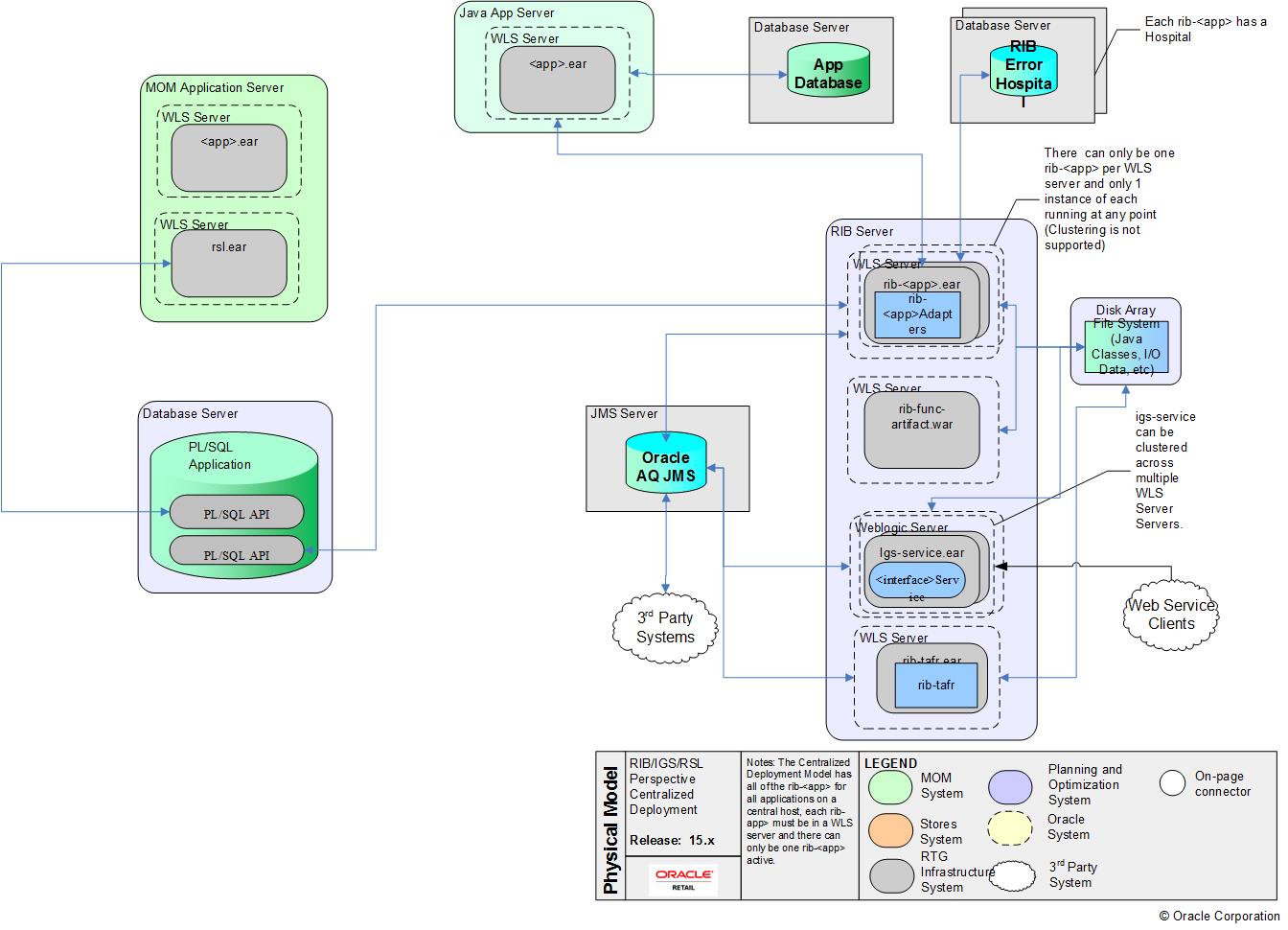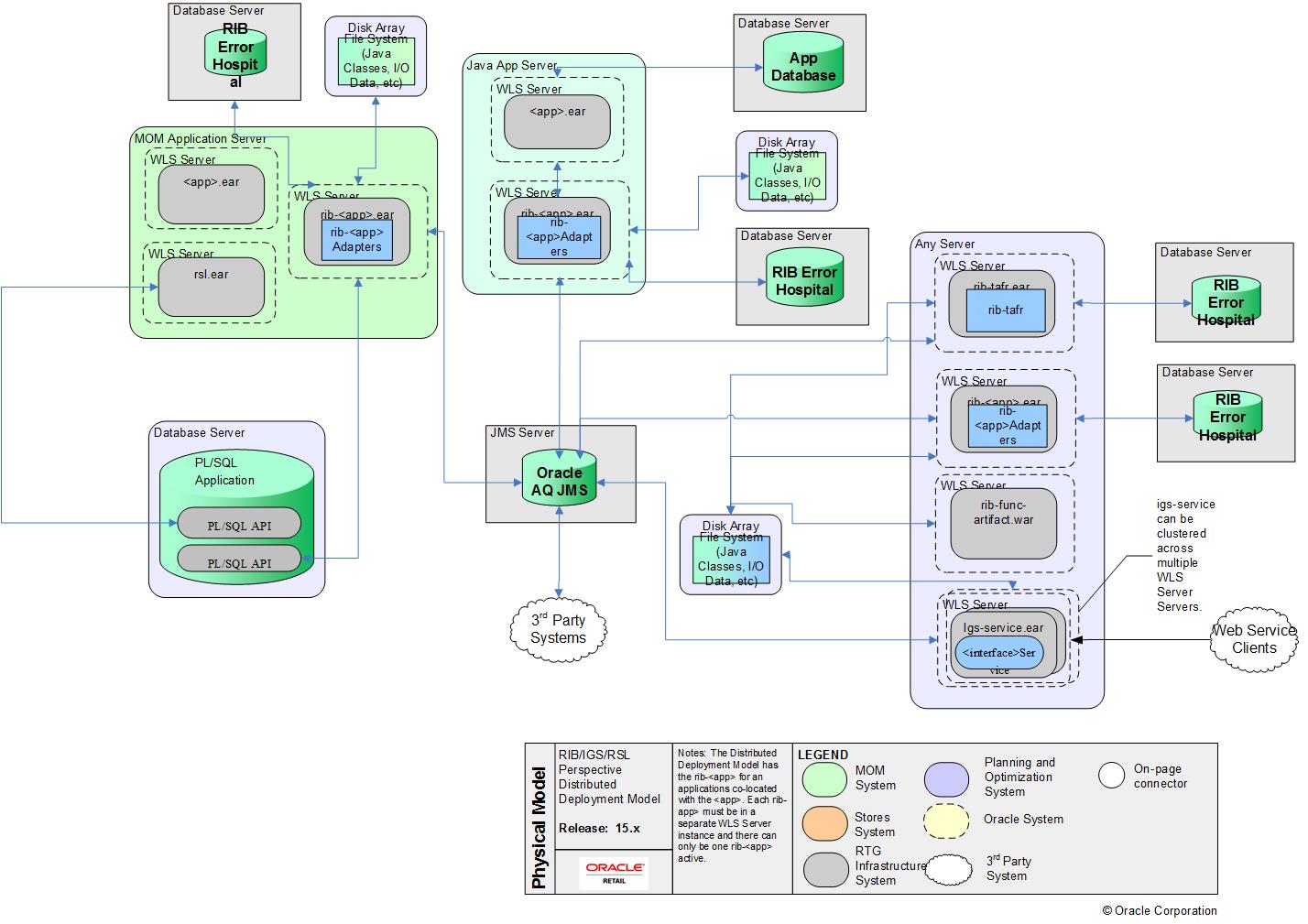Oracle® Retail Reference Architecture
Physical Architecture Model
October 2015

Contents
Table of Contents
Intended Audience for this Document
IGS and WebLogic Server (WLS) Clustering
Introduction
The physical architecture of a system conveys information on the environments on which a system’s significant components are deployed. This document presents a narrative that provides additional details on each physical architecture model diagram, and gives some of the reasons behind why the suggested deployment was developed.
Note that the system integrator is not tied to a particular deployment model, as each customer’s environment may differ. Rather, the physical architecture presented in the document illustrates an ideal case in which Oracle Retail Workspace - MOM (ORW – Merchandising Operations Management systems) is deployed; the environment may then be tailored to match the customer’s deployment environment.
Intended
Audience for this Document
The intended audience for this document is enumerated in the following list:
· Oracle Retail’s Prospective Customers – through the RGBU Sales and Professional Services organizations, the physical model is used as a tool to allow customers to understand how the components of our systems are supposed to be deployed.
· All RGBU Groups – the entire organization will now have a level-set architecture from which everyone can understand how the significant components of our systems are intended to be deployed.
Oracle
Retail RIB/IGS
The RIB applications can be deployed in a variety of physical/logical configurations depending on the customer’s needs. The deployment decisions made directly affects the performance, availability, scalability, reliability, maintainability of the RIB integration system. Oracle Retail has two recommended configuration alternatives.
- Distributed -- In this
deployment each of the rib application (rib-<app>.ear) is deployed
in the same Oracle Application Server as integrating application
(<app>.ear) but in its own WLS server.
- Centralized -- In this
deployment all rib applications (rib-<app>.ear) are deployed
in a single Oracle Application Server (not WLS server) independent of
where the Oracle Retails apps (<app>.ear) Oracle Application Server
is.
In all cases the rib application (rib-<app>.ear) should be deployed in its own WLS server. It is not recommended to deploy multiple rib applications into the same WLS server, or to have the rib application (rib-<app>.ear) deployed into the same WLS server as the integrating application (<app>.ear).
The core RIB componenets do not support deployment to an active-active cluster. This limitation is not technical, but functional, and must be observed to preserve message publication sequence preservation, a core RIB requirement.
Centralized RIB Deployment
In this deployment all rib application (rib-<app>.ear) are deployed in a single Oracle Application Server but in separate Java EE containers (WLS servers). The integrating applications (<app>.ear) are deployed in their own separate Oracle Application Server. There will be only one JMS server and all participating rib-<app> will be configured to use the same JMS server.

Distributed
RIB Deployment
In this deployment setting the rib application (rib-<app>.ear) is deployed in the same Oracle Application Server as the integrating application (<app>.ear). Logically rib-<app>.ear and <app>.ear are closely tied to each other, so it makes sense to also deploy them physically close to each other within the same Oracle Application Server. There will be only one JMS server and all participating rib-<app> will be configured to use the same JMS server.

IGS and WebLogic Server (WLS) Clustering
The core RIB componenets do not support deployment to an active-active cluster. However, the IGS can be deployed to an active-active Oracle WebLogic cluster.
* * *
|
Oracle Corporation
World Headquarters
500 Oracle Parkway
Redwood Shores, CA 94065
U.S.A.
Worldwide Inquiries:
Phone: +1.650.506.7000
Fax: +1.650.506.7200
oracle.com
Copyright © 2015, Oracle. All rights reserved.
This document is provided for information purposes
only and the
contents hereof are subject to change without notice.
This document is not warranted to be error-free, nor
subject to any
other warranties or conditions, whether expressed orally or
implied
in law, including implied warranties and conditions of merchantability
or fitness for a particular purpose. We specifically disclaim any
liability with respect to this document and no contractual obligations
are formed either directly or indirectly by this document. This document
may not be reproduced or transmitted in any form or by any means,
electronic or mechanical, for any purpose, without our prior written
permission.
Oracle, JD Edwards, PeopleSoft, and
Siebel are registered trademarks of Oracle
Corporation and/or its affiliates. Other names may be trademarks
of their respective owners.